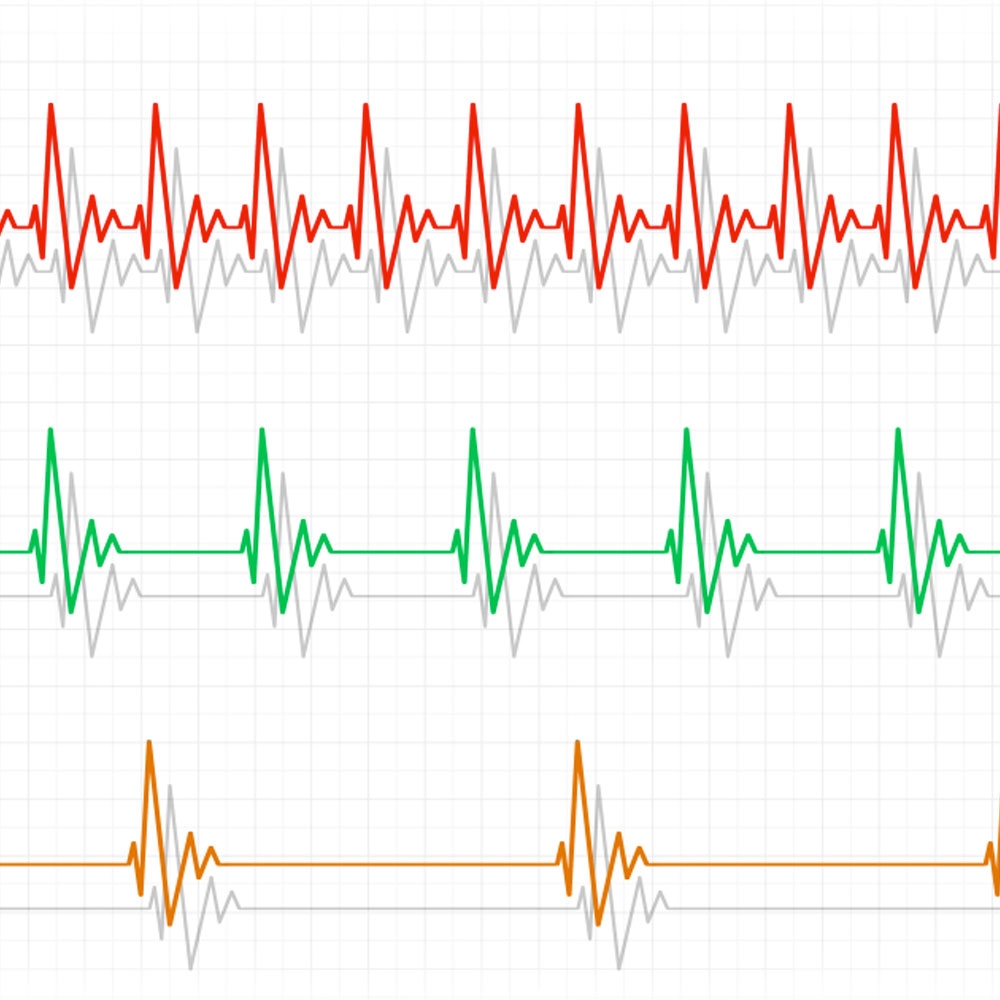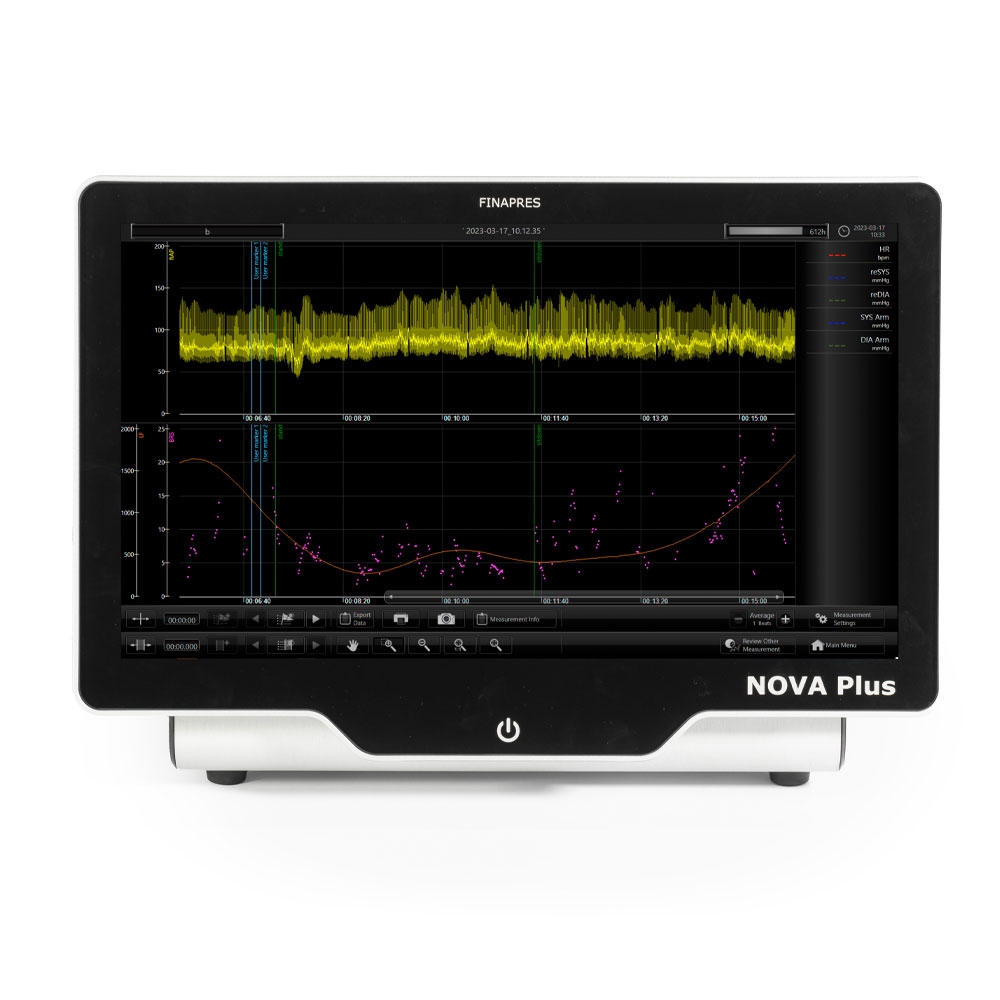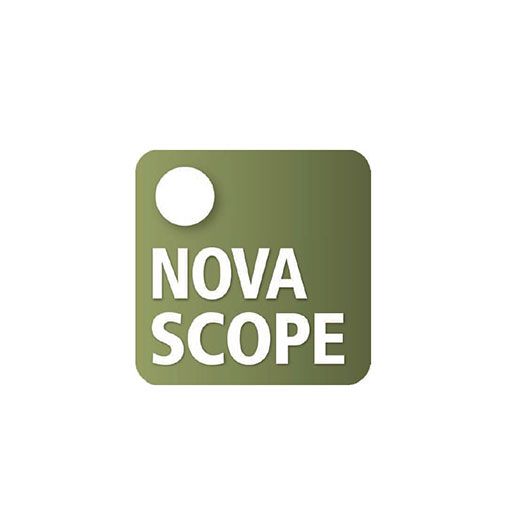The Autonomic Testing software can be upgraded during its lifetime at any time.
Heart Rate Variability (HRV) parameters
Heart rate variability is the fluctuation in time intervals between adjacent heartbeats. Our HRV parameters are derived from the ECG signal measured with the Finapres® NOVA, obtained in time- and frequency domain, and based on a 5-minutes interval. Subsequently, the HRV signals are updated every heartbeat. A filter is applied to detect and remove abnormal beats. The method to calculate the HRV parameters is based on the HRV Guidelines, published by the European Heart Journal [1].

Our AT application provides these parameters:
- VLF: the power in Very Low Frequency range
- LF & LFNorm: the (normalised) power in Low Frequency range
- HF & HFNorm: the (normalised) power in High Frequency range
- LF/HF ratio: the ratio between LF and HF
- RMSDD: the square root of the mean of the sum of the squares of differences between adjacent NN (Normal-to-Normal) intervals
- SDNN: standard deviation of all NN intervals
- pNN50: count of number of pairs of successive NNs that differ by more than 50 ms divided by the total number of all NN intervals
- HRVI: total number of all NN intervals divided by the height of the histogram of all NN intervals
- TP: The total Power
- Beat classification: indicates for each beat whether it is included or excluded for the use of HRV signals
- BRS: Baroreceptor Sensitivity
Baroreceptor sensitivity (xBRS)
The BRS parameter describes the amount of response in heartbeat interval to a change in blood pressure, expressed in ms/mmHg. The BRS parameter is obtained from the systolic blood pressure signal and derived using a well-validated cross-correlation method, which calculates the correlation between beat-to-beat blood pressure and delayed pulse intervals. The measurement of the baroreflex is a source of valuable information in the clinical management of cardiac disease patients, particularly in risk stratification [2]. More details on the calculation and validation are available in this scientific paper from Westerhof et al.[3].
As an example of a potential application of the AT software, the image shows the immediate blood pressure (reBAP), heart rate, BRS response during a deep breathing test recorded with the Finapres® NOVA.

xBRS method benefits
Compared to other time-sequential methods (such as sBRS) [3,4]:
- xBRS provides more BRS values per unit of time
- xBRS determinations are more equally distributed over time
- 50% reduction of within-patient variance
- No thresholds for pressure and interval variation needed
Compared to spectral method [5]:
- Exact event location in time
- xBRS provides the distribution of BRS per time interval
- No manual editing needed: most artifacts are rejected in the software
References
- Camm, A. John, et al. “Heart rate variability: standards of measurement, physiological interpretation and clinical use. Task Force of the ESC and the NASPE.” (1996): 1043-1065.
- La Rovere, M.T., Pinna, G.D., & Raczak G. “Baroreflex sensitivity: measurement and clinical implications”. Annals of noninvasive electrocardiology: the official journal of the International Society for Holter and Noninvasive Electrocardiology, Inc, 13 (2), 191–207.
- Westerhof, Berend E., et al. “Time-domain cross-correlation baroreflex sensitivity: performance on the EUROBAVAR data set.” Journal of hypertension (2004): 1371-1380.
- Westerhof, Berend E., et al. “Time course analysis of baroreflex sensitivity during postural stress.” American Journal of Physiology-Heart and Circulatory Physiology (2006): H2864-H2874.
- Laude, Dominique, et al. “Comparison of various techniques used to estimate spontaneous baroreflex sensitivity (the EuroBaVar study).” American Journal of Physiology-Regulatory, Integrative and Comparative Physiology (2004): R226-R231.

.jpg)



